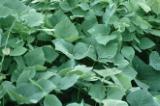Invasives 101
Invasive non-native species pose a serious threat to native plants, animals, and ecological systems -- in fact, they are now regarded as the second-leading threat to imperiled species, behind only habitat destruction. Unchecked by natural controls, invasives compete with and displace native plants, animals, and other organisms and change the cycles and functions of ecological systems.
Attention to the problem of invasive species often focuses on their costs to and impacts on agriculture, ranching, forestry, and industry. The price they exact from our natural forests, grasslands, and waterways is at least as great. For example, of 40 North American freshwater fishes that have become extinct over the past century, for example, invasive species were a contributing factor in more than two-thirds of these extinctions.
Introduced -- either intentionally or accidentally -- into areas outside their natural ranges, invasives affect native biodiversity in a number of ways. They may compete directly with native species for food or space or indirectly by changing the food web or physical environment. They may also prey on or hybridize with native species.
Rare species with limited ranges and restricted habitat requirements are often particularly vulnerable to the influence of these alien invaders. This is especially acute in island environments, such as Hawaii, where most species evolved in isolation -- without continental competitors, predators, and pathogens -- and lack defenses against foreign invaders.
An Accelerating Problem
As global travel and trade increase, pathways for invasive species to establish themselves in new lands are increasing accordingly. San Francisco Bay, a global shipping crossroads, is invaded by a new alien species on average every 12 weeks. A few other recent invaders include the
- Northern snakehead, discovered breeding in a Maryland pond during the summer of 2002.
- West Nile virus, a disease organism first appeared in the United States in 1999
- Emerald ash borer, an exotic beetle discovered in southwest Michigan in 2002
Combating Invasives
Because invasive species have a profound affect on vital sectors of the economy as well as on wildlands and endangered species, a broad coalition has formed to combat the problem. Fighting invasive species received a huge boost in 1999 when President Clinton signed Executive Order 13112, which is designed to "prevent the introduction of invasive species and provide for their control and to minimize the economic, ecological, and human health impacts that invasive species cause."
The National Invasive Species Council was created to coordinate the activities of the various federal agencies involved and engage industry, academia, and the environmental community. The Council has issued a National Management Plan that offers a blueprint from which the U.S. federal agencies, along with their partners, can work to minimize the significant impacts of invasive species.
Though rarely easy or quick, on-the-ground efforts can slow, stop, or reverse invasive infestations. Doing so requires work on four fronts:
Prevention of Additional Introductions
The best and most cost-effective solution is to prevent the arrival of new alien pests in the first place.
Early Detection and Rapid Response
Finding new outbreaks early, together with aggressive eradication campaigns, is the next best solution.
Control and Management of Established Problem Species
If the invaders cannot be eradicated, or already are established, containing their spread and controlling their numbers can help minimize their effects on natural systems and biological diversity.
Restoration and Recovery of Natural Ecosystems
Controlling problem species is not enough; the affected native species and ecosystems also must be restored and protected.
Additional Resources
iMapInvasives is a five member partnership working to facilitate the management and sharing of invasive species information, including extent of infestations, search efforts, and treatment outcomes.
National Invasive Species Council is the U.S. federal government's official coordinating body on invasive species issues.
USDA National Invasive Species Information Center is an international partnership of scientific and technical experts focusing on minimizing the spread and impact of invasive species, including a database
NatureServe Explorer now includes these impact ranks, or "I-ranks", for hundreds of non-native plant species of the U.S. Individual "I-ranks" (high, medium, low, or insignificant) are listed in the reports for each individual species.
The United States Geological Survey's Nonindigenous Aquatic Species site is a repository for biogeographic accounts of introduced aquatic species.
Virginia DCR’s Natural Heritage Program hosts a list of regional, national, and international programs on invasive species.
Precious Heritage: The Status of Biodiversity in the United States, a highly regarded 1999 book on the status and condition of the nation’s biodiversity, includes the analysis by Wilcove et al. establishing invasive species as the second-leading threat to imperiled and endangered species.
The Nature Conservancy’s Global Invasive Species Team worked to abate the damage caused to native biodiversity by the human-facilitated introduction of non-native, harmful invasive species. The Team was de-funded in 2009, but some of its content remains hosted elsewhere.
Go Straight to Your State
Learn about conservation and open space in your state.




